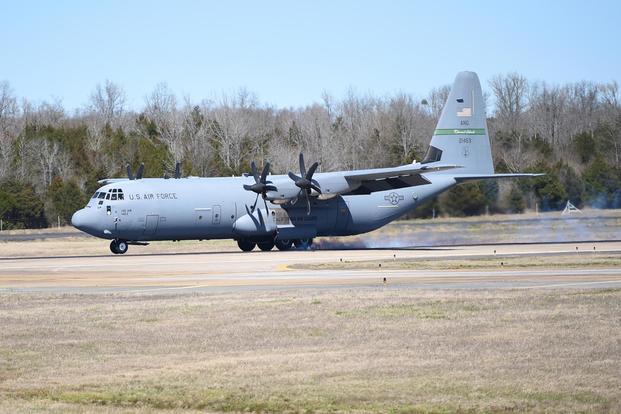The U.S. Air Force has given the OK for a majority of its C-130 Hercules fleet to fly again after about a quarter of its cargo aircraft were grounded last week for precautionary inspections.
As of Aug. 12, 88 aircraft have been inspected and 87 returned to service, Air Mobility Command spokeswoman Rose Riley told Military.com on Tuesday.
One aircraft was "identified with a crack, and appropriate measures are being taken to address and repair it," Riley said in an email.
"Tremendous progress is being made to inspect all remaining affected aircraft, and we continue to safely support operations around the world," she added.
Related content:
- Air Force Grounds More than 100 C-130 Aircraft over Wing Crack Worries
- Navy and Marine C-130s Still Flying After Air Force Found 'Atypical Cracks'
- Air Force Takes C-130s Out of Service to Examine Suspect Propeller Blades
Last week, Gen. Maryanne Miller, head of AMC, ordered 123 of the 450 C-130 models on Air Force flight lines to be stood down as a safety precaution after "atypical cracks were discovered on the lower center wing joint," also known as the rainbow fitting, according to a service news release.
The order applies to C-130H and J-model aircraft "that have not received the extended service life center wing box and have greater than 15,000 equivalent flight hours," officials said at the time.
Those aircraft began an "immediate time compliance technical order (TCTO) inspection to identify and correct any cracking to ensure airworthiness of these C-130 aircraft," AMC said.
Rainbow fittings provide structural support within the wings. Over the last few years, fatigue cracks have been common in the wing's center structure.
There were 96 H and 36 J variants impacted. Of those, 123 were on the flight lines. Another eight aircraft were already in depot; another was transferred to the boneyard, according to AMC.
Maj. Jonathan Simmons, another AMC spokesperson, said Tuesday that the 88 aircraft already inspected were among the 123 C-130s that were in "active service at the time of the [time compliance technical order]."
"This is significant progress, and we are proud of the hard work our airmen are putting in to thoroughly inspect and safely return these planes to the skies," he said.
AMC did not provide a timeline for completing the inspections or finishing any required repairs.
The service flies H and J models; the C-130E was retired in 2012. It also flies the AC-130J/U/W ground-attack variants; WC-130H/J, a Hercules converted for weather reconnaissance; EC-130H Compass Call, an electronic warfare variant; and the military information support operations EC-130J Commando Solo. There are also the special operations MC-130H Combat Talon II and MC-130J Commando II; and Arctic mission LC-130H Hercules.
The Air Force said it would share its findings with other services that fly C-130 models.
The Navy and Marine Corps began their own assessments of their C-130 aircraft following the Air Force's announcement. While the sea services have not grounded any C-130 aircraft, Naval Air Systems Command's tactical airlift program office began evaluating the fleet for problems, Lt. Travis Callaghan, a spokesman for Naval Air Forces, told Military.com on Friday.
The Navy and Marine Corps fly the C-130T, KC-130T and KC-130J.
Earlier this year, the Air Force took 60 C-130H model aircraft out of service to examine and replace engine propeller blades that inspectors deemed risky because the blades were manufactured before 1971. Many were removed as a safety precaution.
-- Oriana Pawlyk can be reached at oriana.pawlyk@military.com. Follow her on Twitter at @Oriana0214.












